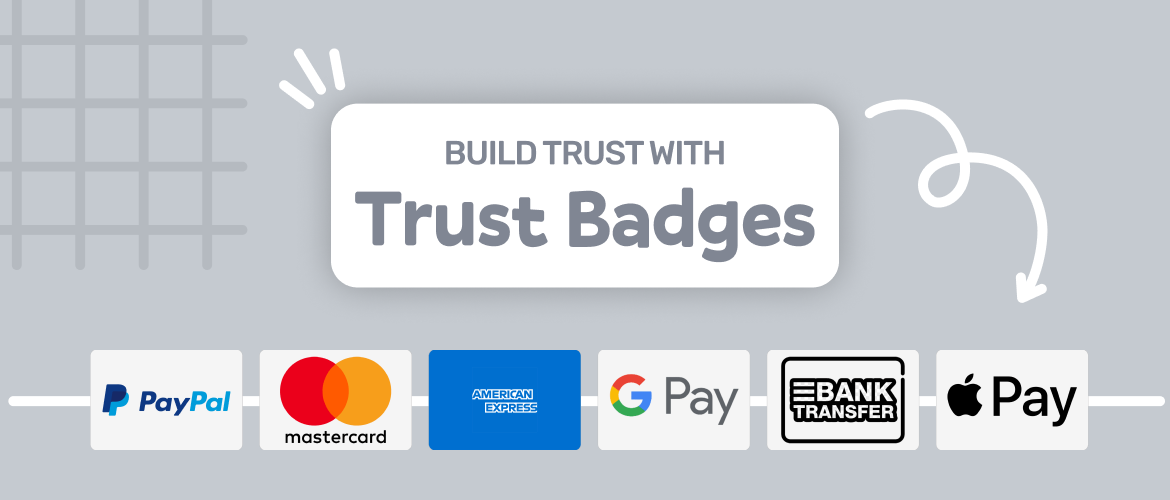1.75 million merchants sell on the Shopify platform worldwide, and the business done on Shopify has contributed a whopping $79.5 billion in 2021 alone!
Shopify customers include major brands like Nestle, Pepsi, Unilever, and Budweiser and innovative brands like Gymshark, Hawkers, Leesa; moreover, celebrities like Kylie Jenner, Eminem, Justin Bieber, and Kanye West has launched their eCommerce brands using Shopify.
Further, eCommerce revenue is predicted to grow to $5.4 trillion by 2022- according to Statista. We now have this thought: How?
How can you tap into some of those big numbers? How to increase sales on your Shopify store?
In this blog post, we’ll take you through various ways to bring traffic to your Shopify store and increase sales.
From here, you can cherry-pick ideas that suit your business. As a bonus, we have also noted down some extraordinary Shopify apps to help you get started right after.
How to Get More Sales on Shopify: 14 Overlooked Ways
From increasing your Average Order Value (AOV) to building customer loyalty, all the way to affiliate marketing and other strategies, you are going to take over your customer's minds and get them to purchase from your online store.
The goal is to pull in targeted traffic (people interested in what you have to sell) to your online store through some kind of a loyalty program. An increase in free Shopify traffic means an increase in sales.
Buckle up because this is going to be a long one.
Let's dive into it...
1. Clear product images
93% of consumers say clear product images help them decide whether or not they want to buy something. This means 7 on 10 people will not buy if they can't see what they are buying!
While optimizing your product pages might seem to be the Holy Grail for increasing sales on Shopify. However, the very first impression is made by the photos you showcase on the main page of your store.
Customize your Shopify store for good images.
The best eCommerce photos are clear. It shows customers exactly what they're buying before they buy it.
Secret tip: Show your products in lifestyle images, not just posed shots. This converts well because it makes the viewer feel like they're in the picture and using the product themselves.
With Mason, you don't have to spend time editing Shopify product images. All the major image editing tools are built right in. The edit you make to the image can be updated everywhere across your store with just one click. You can then also share the images on social media platforms as you would any other image – directly from Mason.
This helps you maintain a steady stream of fresh product content on social media. You've likely heard about the importance of maintaining a strong social presence. If not, then read on because we cover how social media plays an important role in pushing your sales higher.
🎯 Bonus (recommended app): Mason helps eCommerce store owners run a high converting storefront.
2. Product descriptions
Now that we have covered product images, we need to emphasize product descriptions. How that matters- it allows you to explain and introduce your customers to the features, benefits, and specifications of the product you want them to purchase.
The details you mention about the products assure your customers that they will receive exactly what was promised.
When creating a product description, it must be accurate, thorough, and intriguing enough to draw customers in and make them want to purchase your item without hesitation.
Ruggable, one of the most popular Shopify stores in the home decor category, highlights the benefits of their product right on the homepage of their website.
The pain points of the customers are highlighted with words like “germs,” “messy,” and “machine-washable rug.”
Have a well-described short narrative on your website that chalks out the USP of your product. Speak to your customer in their tone, show them what they are missing and how they can have it.
🎯 Bonus (recommended app): Product Description Writing, Advanced Product Descriptions
3. Social proof
Let's be honest. You're not going to make sales if your customers don't trust you.
Around 55% of e-consumers say they don't trust companies as much as they used to, and when unaware of the brand, 93.4% of online shoppers trust customer reviews. Even Shopify says that social proof is a powerful persuasion technique.
Hence, it becomes more important to show social proof on your ecommerce store. It positively impacts your sales conversions and customer loyalty.
How do you use social proof to increase Shopify sales? How will your customers figure you are reliable?
- Display photos of happy customers on your homepage. This will help build trust for potential customers who visit your site.
- Add testimonials or reviews from industry experts or celebrities (with permission, of course). These examples show your potential clients that you have great products.
- Customize your Shopify store with product labels to show your customers what other buyers like. Use labels like "bestseller," "trending," etc.
"BESTSELLER" - to show that the phone cases are the best selling product they have in store. "PET FRIENDLY" - to show these blankets with your favorite pup printed on them are also safe for your pet. It is pet-friendly. "ECO FRIENDLY" to show their phone case is eco-friendly and does little to no damage to your environment.
🎯 Bonus (recommended app): ModeMagic - update those little labels right on top of your product images with just one click.
4. Optimize you Shopify store with SEO
Optimizing the Shopify store for Search Engine Optimization (SEO) is the best way to make sales on Shopify without running any ads.
SEO makes your store easily discoverable on search engines like Google, Bing, etc. Shopify has excellent built-in settings to create SEO-friendly pages, giving you updatable meta fields (title, description, URL slug), automatically generating sitemaps, 301 redirects, and canonical URLs.
This all ensures that your homepage, product pages, collections pages, and more are indexed and findable on the most significant search engines.
Here's an example from one of the leading Shopify stores, Freshly Picked.
Susan Petersen, the founder of Freshly Picked, attributes her store's success to the regular blogging and Shopify SEO tool kits. And one can see why.
A deeper dive into Ahrefs shows that Freshly Picked ranks for a whopping 10,000+ keywords and is receiving an estimated 14,000 organic visitors per month:
The Freshly Picked homepage ranks for many important keywords like "baby moccasins" – searches that definitely help Freshly Picked generate tons of sales.
This clearly shows the power of a well-optimized site. A well-optimized site (and its category and product pages) can rank for tons of important, buyer-friendly keywords that eventually lead to sales in your store.
For more tips on how to grow your business beyond SEO, you might find this ThriveMetrics article on strategies to grow your business helpful.
🎯 Bonus (recommended app): SEO Booster - SEO Marketing
5. Email marketing to drive free traffic.
Emails can be slow and frustrating — that is, if not properly managed and utilized.
Building a list of receivers who'd like to hear from you is the place you begin at. Emails are a great way to push the traffic to visit your eCommerce store.
- Email your subscribers before you launch a new product. Get opt-ins and create a list of people interested in it to remind them of the launch. You can also use this list as a VIP list, letting them know of any upcoming sales campaign in advance.
- Create a post-purchase email. Send a confirmation email and a proof of delivery showing your customers a timeline of when to expect their product delivery.
- Ask for reviews in your Shopify store's newsletter and in your post-purchase emails. These reviews can drive even more sales.
- Use abandoned cart email automation. The idea here is to offer people who leave their carts some incentive to come back and complete their purchases, like knocking off 10% of their total or offering free shipping if they shop within 24 hours of abandoning it.
Additionally, here are a few quick tips you might want to follow to get the best return on emails sent:
- Use Personalization
- Segment Your List
- Offer Discounts or Promotions
- Share Your Brand Story
- Make it fun for subscribers by offering them special referral points
- Make Clickable Calls-to-Action (CTA)
🎯 Bonus (recommended app): Omnisend, Shopify Email
6. Increase Average Order Value (AOV)
Your customers will always look through additional products if you give them a way to do so.
No matter what you're selling on Shopify, there's a good chance that you can upsell and cross-sell to increase your sales. With product recommendations, you can present customers with relevant products that complement what they view or add to the current shopping cart.
It will also make them feel like they've got a great deal. In general, it makes sense to approach cross-selling like this:
"What else can I sell my customer that he can make use of?"
Cross-selling means recommending unrelated products to people who've already purchased something from your store. Make use of the “customers who bought this also bought” feature.
🎯 Bonus (recommended app): Zipify OCU, Wiser product recommendations - show customers related products and recommend products based on their individual needs and past purchases.
7. Easy payment methods at your Shopify store
The major reason for people to shop online is convenience.
You take away their convenience when you don't add their preferred payment method. That, in turn, takes away your sales.
That makes payment methods one of the most overlooked ways to increase Shopify sales. Overlooking something so critical to your store might be the biggest mistake you can make.
Deciding what payment methods to offer requires some research and careful consideration. Check what payment gateways people use across countries and integrate your customer needs.
If you want to let your customers pay using a credit card, then you can use Shopify Payments or a third-party provider too.
Applications such as Depo (by Sidepanda) also make payments easier by providing a security deposit management solution, especially for Shopify merchants. Depo helps turn those missed sales into deposits, and also helps you charge customers for pending payments.
There are also several ways for customers to pay online without using a credit card, like PayPal, Facebook Pay, Amazon Pay, and Apple Pay. You might also want to accept alternative methods of payment like cryptocurrency.
🎯 Bonus (recommended app): PayPal, Amazon Pay, Sidepanda
8. Utilize push notifications
Push notifications are a great way to re-engage customers with your site after they've left your store (or never even made it there in the first place).
Push notifications are messages sent to users' devices – smartphones, tablets, etc. These messages are displayed in their notification center (on their mobile devices).
Here are a few things you can do with push notifications-
- Remind customers of their purchases to help them complete their orders. Prompting them with a friendly reminder that includes a direct link back to your store can save you valuable sales.
- Welcome new customers by personally welcoming them into your brand!
- Send discount codes or other special offers directly to your customers' mobile devices. Not only will they feel appreciated and incentivized to come back, but they'll also be able to take advantage of your sales right away.
🎯 Bonus (recommended app): PushOwl, Smart Push Marketing
9. Social media marketing to create noise
Social media is a two-way street.
Being on social media gives you multiple opportunities to interact and be in front of your customers. Social media gives brands an easy way to connect with customers personally and build trust and loyalty.
So, naturally, your eCommerce brand will have its presence across those social platforms where your customers are.
There are just so many of them! Facebook, Twitter, Reddit, Pinterest, Tumblr, Instagram, Snapchat, LinkedIn, and then some more...
To grow on different platforms needs different optimizations and strategies. Tailoring social media content to suit your target market is a great way to bring in potential customers and increase sales. For instance, live chat on social media is quite popular today and brands are using it to boost their sales considerably.
Los Angeles-based brand ColourPop, burst onto Instagram in all of its colorful glory and captured the hearts — and lips — of seemingly everyone. This brand launched itself solely via social media!
After you have Mason set up with your Shopify store, you can use it to edit your product images and directly update them on your social channels. This allows you to save time by automating your marketing efforts online.
🎯 Bonus (recommended app): Outfy, Social card
10. Influencer marketing
How can we talk about social media but leave out influencer marketing as a strategy, eh?
Apart from having a stellar Instagram profile, ColourPop has also collaborated with huge names such as Disney and Sofia Nygaard, which has generated a large chunk of ColourPop customers through social media.
After all, influencer marketing is a way of leveraging influential people in your niche to promote your products. The influencers you choose to collaborate with will be responsible for the initial outreach to their followers, getting your store and products in front of them, and hopefully converting them into customers.
52% of 13- to 37-year-olds in the US say they're more likely to purchase a product recommended by their favorite online celebrity.
The influencers you choose to market your products resonate with what your brand stands for. Like ColourPop collaborates with social media mavens who live and breathe makeup.
By the way, did you know that the manufacturer of ColourPop also makes products for Kylie Cosmetics?
Kylie Cosmetics is globally owned by world-famous influencer and fashion icon Kylie Jenner.
Jenner launched her beauty brand on November 30, 2015, with the $29 Kylie Lip Kit, which immediately sold out.
She has direct access to over 294 million people’s Instagram feeds, and countless people set out to copy her aesthetic choices — from her body-conscious fashion style to her funky hair colors to even her famously plumped lips. Her life is her brand.
🎯 Bonus (recommended app): Linkr, Instagram influencer marketing
11. Excitement with contests and giveaways
There are several reasons why customers engage with contests, but it always boils down to one thing - the customer wants a chance to win something they want. To put it simply, when playing a game, there's an irresistible urge to win, which can be used as a powerful tool for business growth.
The oldest marketing hack up the sleeve: the joy of a freebie!
Contests and giveaways are a great way to get your store in the spotlight, generate some buzz, and get more people to buy from you. It's important to remember that not all contests and giveaways will work for your store.
Influencer marketing has a high value and is often done on social media.
As a general rule of thumb, if you're selling designer purses for $100 and you offer one as a contest prize, but then only give away a $5 gift card, then that's not going to generate much excitement.
Whatever kind of contest you choose, there are many things you can do to make it more successful than just randomly giving away prizes. Here are some ideas:
- Make sure people know about it.
- Have a short contest period.
- Make sure only a couple of people can win, so people feel like they have a shot of actually winning.
- Make sure the prize is valuable enough that people will want to share their entry with others.
🎯 Bonus (recommended app): Giveaway Ninja, Social Boost
12. Personalize the shopping experience
Personalization is the art of tailoring a product to your customers’ needs. The goal is to create a more relevant, meaningful connection between you and your customers.
- Offer more than one size or color. This offers shoppers the ability to customize their purchases, leading to higher conversions and repeat purchases.
- Put a follow-up reminder in your shopping cart. Sometimes customers add items to their cart and leave before checking out, either because they changed their mind or got distracted. Remind them about their purchase by sending a friendly message like "3 items waiting for you."
- Customize your Shopify to an extent where you can highlight the benefits of buying from you, such as: "Best quality," "Guaranteed satisfaction," "Lowest price," etc.
- Send an order confirmation email as soon as you receive an order. Ensure that the customer knows that their order has been received and processed. This will put their mind at ease.
- Send a shipping notification email. When you ship the ordered package, make sure your customers know it. Also, include tracking information in this email for them to track where their package is.
- Offer an exclusive discount or promotion code for new customers only. Alternatively, if you have a newsletter or other type of advertising, deliver new customers a coupon code for their first purchase only if they sign up.
There are no caps to the limits you can put on yourself to customize your Shopify store to offer your customers a seamless and personalized experience.
🎯 Bonus (recommended app): Teeinblue, Zepto
13. Paid campaign
With paid ads, you get to put yourself in front of the customer you couldn't get with the organic marketing efforts.
As long as you are making more than you are spending, it's an excellent way to drive traffic to your store.
When running ads, tailor it to be very specific to the product you are offering.
- Use the exact keywords in your ad that you would use in a Google search.
- Include a call-to-action that entices people to click through to your Shopify store. For example: Buy Now, click here, get it now.
- Lastly, consider running retargeting ads on Facebook or Google after someone has visited your site but not purchased anything. These ads will show products they viewed while browsing your store and encourage them to come back and buy.
For example, if you sell t-shirts for cat lovers, you might want to target people who have shown an interest in cats on Facebook. The good news is that Shopify stores are eligible for free Google Adwords credit when they run their first campaign through Google Adwords.
14. SMS marketing
It is almost the same as email marketing or social media marketing… With SMS marketing, the difference is that you can even reach your customers who are otherwise not on emails or social media.
- Send them special offers.
- Remind them of your services.
- Send them coupons for freebies or discounts on their next purchase.
- Send them a personal message on special days such as birthdays and anniversaries.
Applications such as Novochat help you engage with customers better, through chat. Given that text messages (especially on Whatsapp) have a high open rate, this can be a useful medium to engage with customers and reduce abandoned cart problems.
🎯 Bonus (recommended app): Omnisend
Conclusion
Remember, whichever way you choose to leverage to get more sales, you’ll always need to have a strategy in place. This strategy will help you be aligned with your end goal - which is to increase sales on your eCommerce store.
There are numerous ways to design your store, depending on your niche. What works for someone else is not guaranteed to work for you.
Select a few and get started. See what works best for your business.
Try out Mason's 7-day free trial to get one step closer to increasing sales. There is also 24x7 support to help you with your queries.
Stop fretting; here we go now, seeing you take your sales higher and higher.







